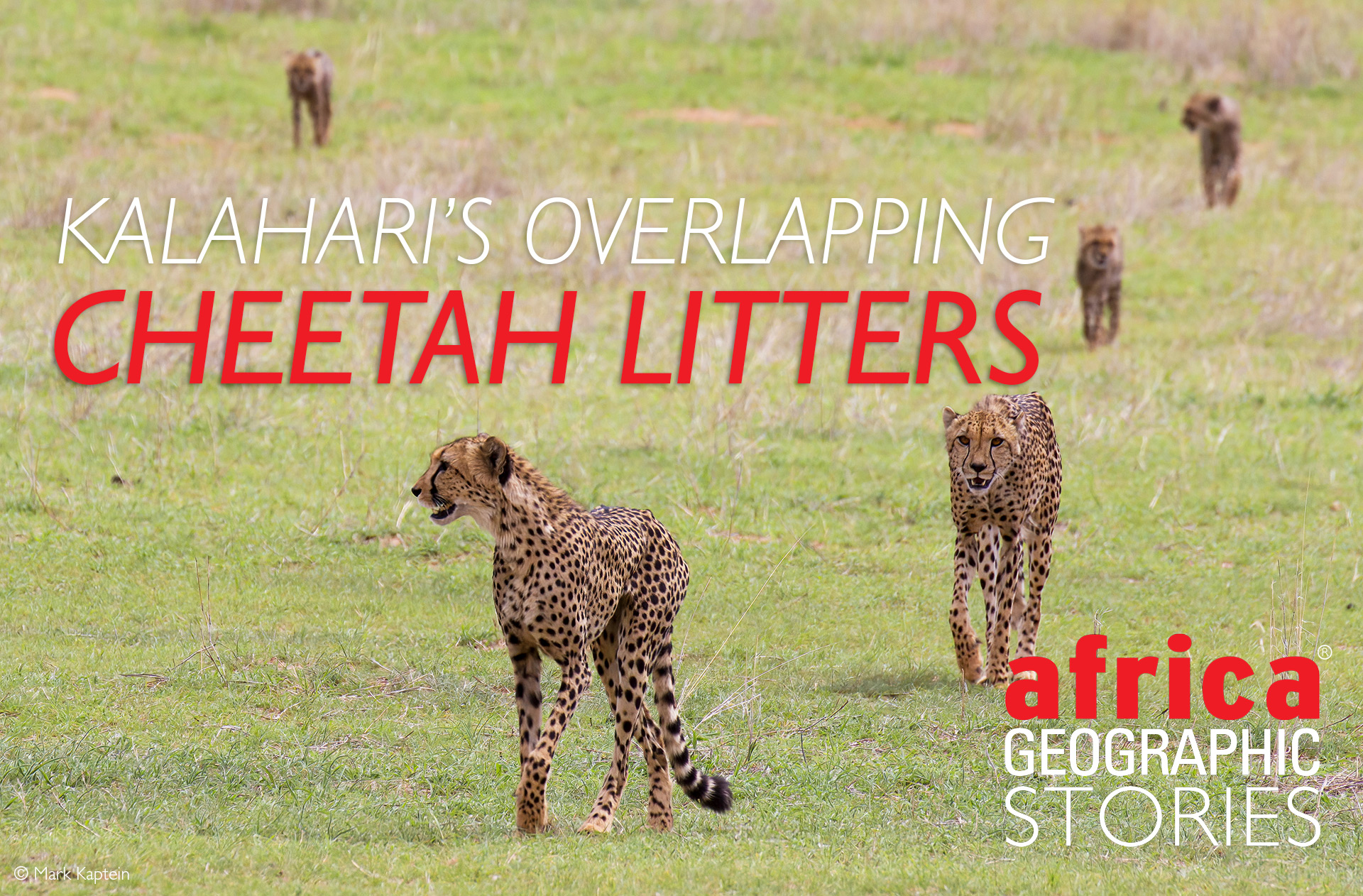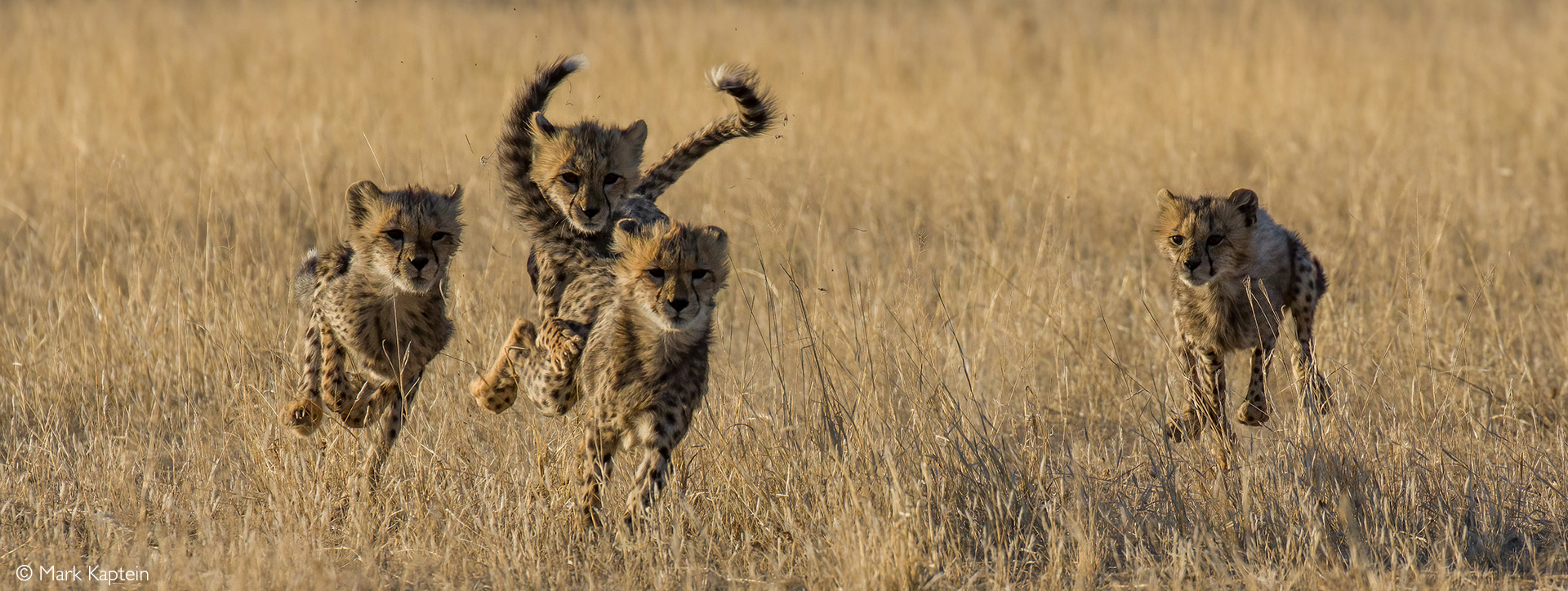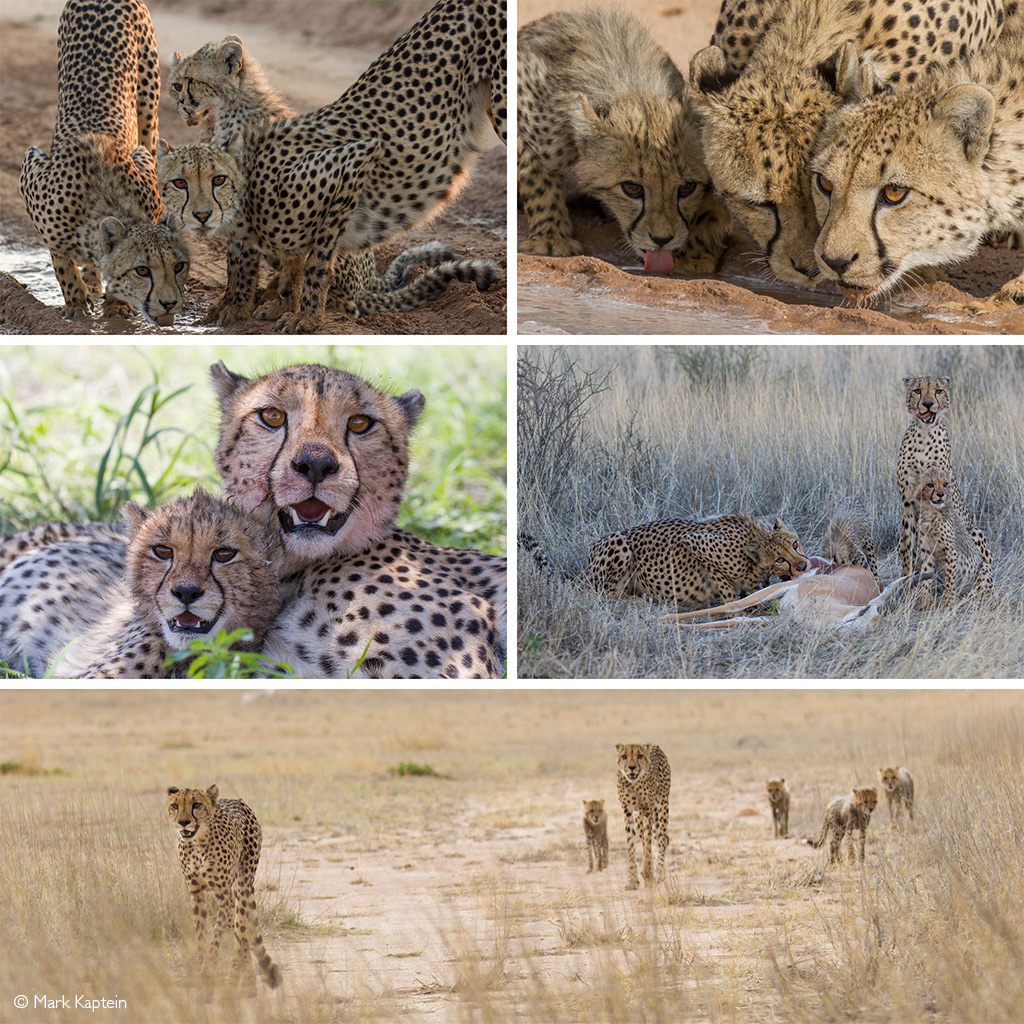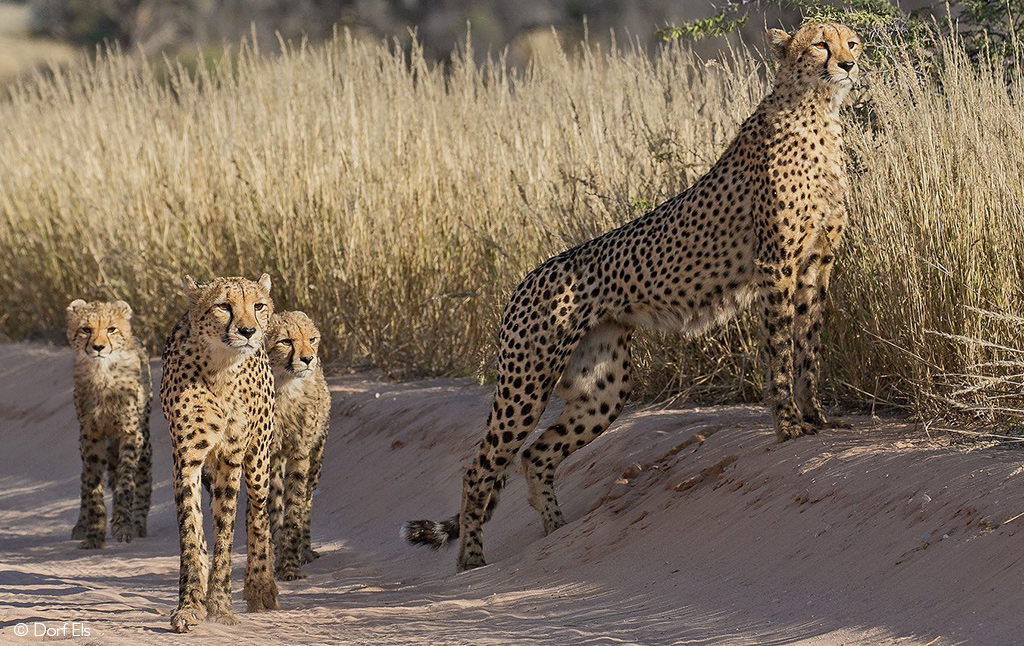
Extraordinary cheetahs of the Kalahari


Somewhere far north in the Auob riverbed in the Kgalagadi Transfrontier Park of South Africa, a female cheetah wanders out of the dunes. Her eyes lock onto a springbok and she moves closer to her unsuspecting quarry. Moments later she is at full speed. The springbok sees her and runs – but it is too late. The cheetah sits on the side of the dune, panting heavily, successful in her mission to feed her family. So far, this is nothing unusual. A female cheetah hunting a springbok to provide for her growing cubs is a daily occurrence in the southern Kalahari Desert. On this occasion, however, everything is different.
Her sub-adult male cub, 15 months old, appears over the dunes. Behind him four small bundles of fur appear, hardly recognisable as cheetahs, emerging from the den to join their mother and older brother on the kill. The mother – dubbed “Lizzie” by researchers from the Kalahari Leopard Project, was born in 2016. Her mother is known to researchers as “Corinne” and is currently one of the oldest cheetahs in the Kgalagadi Transfrontier Park.
Cheetahs are one of the most intensively studied large carnivores on the planet. But a female raising two of her own litters of different age classes at the same time is something scientists have never seen before. The first sighting of these cheetah cubs occurred in October 2021. After observing this cheetah family for some time, the Cheetahs of the Kalahari Project has been able to gain insight into this rare occurrence.
In the beginning
The story began in early 2016 when Lizzie was born. Her mother Corinne was one of the best-known cheetahs in the Kgalagadi Transfrontier Park, and both Corinne and Lizzie had been monitored since birth by the Kalahari Leopard Project. Corinne was born in March 2011 and her mother was collared by cheetah researchers Gus and Margie Mills in 2006. Knowledge of the matrilineal bloodline of these cheetahs thus goes back four generations.
After dispersal from her mother, Lizzie became a prolific independent hunter and claimed a home range in the far north of her mother’s range. In June 2020 she had her first litter, of which one male cub – Lokesh – survived the denning phase. He grew up as a single cub and nothing out of the ordinary happened for almost a year.

In May 2021 we noticed that Lizzie started marking, behaviour that is normally only displayed by females in oestrus. Multiple males ventured far out of their normal territories to visit Lizzie’s home range. When we received news of sightings of Lizzie accompanied by different males during May, we still did not expect her to get pregnant. Her 11-month-old male cub was still far from independence and cheetah females do not usually enter oestrus unless their current cubs have dispersed, are very close to dispersal age, or if all of their cubs die. But during the winter months we didn’t see or hear anything about Lizzie. We grew fearful that something had happened to her and her cub. Thankfully, they reappeared in September while hunting springbok in the riverbed. But we noticed something odd: Lizzie had suckling marks.
On 30 October 2021 our suspicions were confirmed when Lizzie finally showed her new litter of four cubs to the world. Cheetah females keep their litters hidden in a den for about eight weeks. Thereafter the mother will start to take them with her wherever she goes. Most cubs are fully weaned within three weeks after emerging from their den and they are introduced to fresh meat as soon as the denning phase is over.
From the moment her new litter emerged we monitored this special family on a daily basis and recorded their behaviour in detail. Lizzie and her extended family started moving around in their usual home range, allowing us to spend months in their presence.

Navigating new relationships
This situation – an adult female with a new litter of eight-week-old cubs, accompanied by an older cub (a 15-month-old brother in this case), had never been documented by anyone in the wild before. The cubs’ relationship with their older sibling seemed fragile for the first days after their emergence from the den and Lokesh often played too rough with the little ones. We noticed the subadult male seemed caught between two worlds. He tried to hunt with his mother, but also couldn’t resist playing with his younger siblings.

Their behaviour in the next few weeks was remarkable. The subadult male started to take on the role of “surrogate mom”, and the young cubs spent more time with him. He played with them, washed them and called for them when they lagged behind. This gave Lizzie the opportunity to focus on hunting efficiently for her large family. He would still accompany his mother during hunts – spoiling quite a few of them! But whenever the two were out hunting, Lokesh would focus on the young cubs if danger emerged. On multiple occasions, jackals threatened the young cubs while Lizzie and Lokesh were hunting. She would often make a call and the subadult male would abandon the hunt and return to his younger siblings. Lizzie often left Lokesh with his younger siblings, seemingly to “babysit” them. The first month flew by and it seemed these young cubs were safe with two older cheetahs looking after them.

Disaster strikes
The young cubs were growing fast and discovering more of their mother’s home range. But moving larger distances meant more chance of running into danger. A shortage of prey and an unusually high density of cheetahs in Lizzie’s home range in January 2022 meant she had to walk up to 20km a day to find food. All four cubs made it into the new year – though one of the four was significantly smaller than the others. The first disaster struck on the night of 7 January.
Lizzie is a skilled hunter. Where other cheetahs usually need to get within 50–100m of their prey before launching a pursuit, she can hunt from wide distances. On occasion, she has even taken the chance to start running at a distance of about 250m from her prey, and been successful. But her determination to succeed in the hunt landed her in trouble that night.
Lizzie missed a hunting opportunity that afternoon and so followed a group of springbok into the twilight. After we followed her tracks the next day, it became evident that she had walked over 7km on a moonless night in pursuit of prey. I struggled to locate the family at first. But we soon spotted Lizzie coming down from the dunes, followed by a very nervous Lokesh and only three small cubs. Going back on their tracks, we found that one small set of tracks had gone missing. One of the cubs had likely been separated from the family. From tracking and circumstantial evidence we determined black-backed jackals had killed the cub after it was lost, and we later found seven jackals eating the cub’s remains.
Lizzie and her family later returned to the area where the tracks had indicated the cub had gone missing. They called for the cub incessantly for the next two days, staying in the area for some time – unusual for Lizzie. The entire family, including the subadult male, were calling for long periods of time during the days after the loss.
After that, prey became even more scarce and Lizzie would walk many kilometres a day to find the odd springbok in the riverbed. She went into the dunes to hunt steenbok on occasion but often returned unsuccessful.
On 18 January Lizzie and her family walked 10km to a waterhole to drink. Unaware of three lions sleeping nearby, Lizzie and her family walked dangerously close to them through the riverbed. A sudden thunderstorm created a dust devil of sand and visibility decreased. A lightning strike woke the lions, who then noticed the cheetah and cubs. The sandstorm created cover for the lioness and she charged the unsuspecting cheetahs. She killed one cub. Both Lizzie and Lokesh sprinted back to distract the other lions from killing more youngsters. Cheetahs are no match for any lion and the two males charged at the adult cheetahs. Lizzie and Lokesh made a narrow escape. One cub was left disoriented, calling for its mother and siblings from the riverbed. Lokesh came back from the dunes and managed to draw the cub away from danger.
In contrast to their actions when losing the first cub, the cheetah family did not remain in the area or call for the cub. They had seen the lions kill the cub and there was no doubt as to its fate.

Greener pastures
After this the family’s fortune changed for the better. The two remaining cubs continued to grow, play and explore the home range. Lokesh’s bond with them stayed strong. He became a better hunter. By the end of May 2022, the family were still together. He would still play with his smaller siblings, but his behaviour towards the now older cubs became more sexual. The cubs responded with more defensive behaviour, less playful than before. The subadult male had remained with his mother for a total of 23 months.
The two young cubs are now big enough to outrun threats and are growing quickly. The Cheetahs of the Kalahari Project will keep monitoring these and other cheetahs within the southern Kalahari and hope to contribute to cheetah conservation in the wild with the knowledge we gain. One thing we know for sure is that cheetahs will never cease to amaze us!
Why is this case so special?
We at the Cheetahs of the Kalahari Project have a few years of experience working with or studying large carnivores in the wild, and we had never heard of a case in which a wild female cared simultaneously for her overlapping litters of different age groups. After consulting friends and colleagues we discovered how truly special this case was. Gus and Margie Mills who conducted the first extensive cheetah study in the southern Kalahari between 2006 and 2012, Vincent van der Merwe from the Endangered Wildlife Trust and Femke Broekhuis from the Serengeti Cheetah Project all have many years of field experience with wild cheetahs, and none of them had ever heard of a case like this. This (to our knowledge) is the first and most extensively studied case of a female cheetah with overlapping litters in natural history.

Resources
To learn more about cheetah behaviour, read here.
Citizen scientists contribute important data to the Cheetahs of the Kalahari Project. If you have been to the Kgalagadi Transfrontier Park in the last ten years and have photographed cheetah there, share your pics and info with the Cheetahs of the Kalahari Project (cheetahsofkgalagadi@gmail.com). Include the location, date and any important additional info. Read more about the project here.
To comment on this story: Login (or sign up) to our app here - it's a troll-free safe place 🙂.![]()








